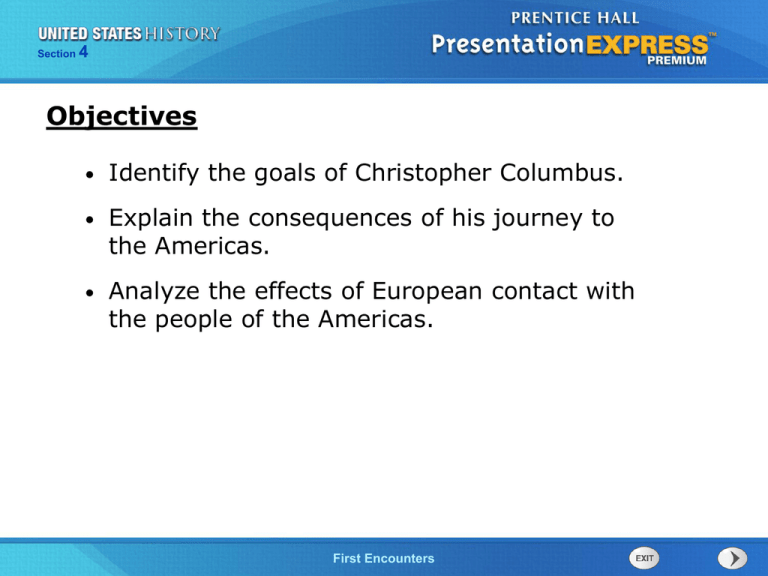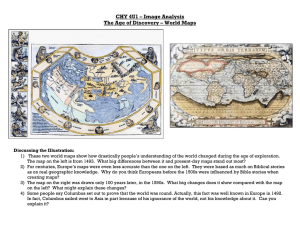Objectives
advertisement

Section 4 Objectives • Identify the goals of Christopher Columbus. • Explain the consequences of his journey to the Americas. • Analyze the effects of European contact with the people of the Americas. The Cold War First Begins Encounters Section 4 Terms and People • Bartolomeu Dias – Portuguese mariner who sailed around southern Africa in 1487 • Vasco da Gama – Portuguese mariner who sailed around southern Africa to India in 1498 • Christopher Columbus – Italian mariner sailing for Spain who in 1492 sailed west to reach Asia but reached the islands of the Caribbean instead • John Cabot – Genoese mariner employed by the English who sailed to Newfoundland in 1497 The Cold War First Begins Encounters Section 4 Terms and People (continued) • Pedro Alvarez Cabral – Portuguese mariner who reached the coast of Brazil in 1500 • Amerigo Vespucci − Genoese mariner who explored South America’s coast in 1501; Europeans mapmakers called the new continents America, a variant of his name • Ferdinand Magellan − mariner whose 1519−1522 expedition succeeded in encircling the globe • conquistador − Spanish soldier who explored and conquered central Mexico The Cold War First Begins Encounters Section 4 Terms and People (continued) • Hernán Cortés − conquistador who invaded present-day Mexico in 1519 and conquered the Aztecs • Moctezuma − Aztec ruler • Columbian Exchange − the global exchange of plants, animals, ideas, and diseases between Europe, Africa, Asia, and the Americas after Columbus made his first transatlantic voyage in 1492 The Cold War First Begins Encounters Section 4 How did European exploration affect the Americas? With the goal of reaching Asia, European sailors continued their journeys of exploration. In 1492, Christopher Columbus landed in the Americas, planning to conquer the land, exploit its wealth, and convert its people to Christianity– a pattern followed by later explorers. The Cold War First Begins Encounters Section 4 In the 1400s, the Portuguese sought a route to India, the East Indies, and China. Bartolomeu Dias • In 1487, Dias used the winds of the South Atlantic to get around the southern tip of Africa. Vasco da Gama • In 1498, da Gama exploited Dias’s discovery to reach India, opening an enormously profitable trade route. The Portuguese dominated the trade routes south and east around Africa. The Cold War First Begins Encounters Section 4 By default, the Spanish looked westward into the open Atlantic. • The Spanish hoped to find islands in the west that they could exploit. • They also hoped that, by leaping from one set of islands to another, explorers could one day reach the coveted coast of China. The Cold War First Begins Encounters Section 4 The Italian mariner Christopher Columbus had heard stories about mysterious lands to the west. Columbus was determined to make a westward voyage in search of China. He hoped to convert the Chinese to Christianity and use their wealth to begin a new crusade against Islam. The Cold War First Begins Encounters Section 4 Funded by Spain, in 1492 Columbus reached the Bahamas, which he claimed for Spain. In all, Columbus made four voyages to what he thought was the East Indies, near Asia. He used force to conquer Native Americans on the islands. The Cold War First Begins Encounters Columbus had not reached Asia, but he had found a land that would bring riches and power to European Christendom—at the expense of Native Americans and African slaves. Section 4 Columbus’s Voyages, 1492-1504 The Cold War First Begins Encounters Section 4 In 1494, Spain and Portugal negotiated the Treaty of Tordesillas. • The treaty drew a boundary line through the midAtlantic, giving the Spanish lands west of the line and the Portuguese lands east of the line. • Other European kings refused to honor the treaty. • No one bothered to consult the Native Americans. The Cold War First Begins Encounters Section 4 Other explorers soon confirmed that, by sailing west, Columbus had reached the shores of two continents previously unknown to Europeans. • John Cabot sailed to Newfoundland in 1497. • Pedro Alvarez Cabral reached the coast of Brazil in 1500. • Amerigo Vespucci explored South America’s coast in 1501. • The crew of Ferdinand Magellan finished circling the globe in 1522. The Cold War First Begins Encounters Section 4 Conquistadors extended Spain’s empire in the Americas, treating Native Americans brutally in the process. • The Spanish killed or enslaved thousands of Native Americans. • Many were forced to convert to Christianity. • The Spanish destroyed their cities, stole their gold, and exploited their natural resources. The Cold War First Begins Encounters Section 4 With steel-edged swords, guns, and horses, the conquistadors destroyed native civilizations. Hernán Cortés conquered the Aztecs. Francisco Pizarro defeated the Incas. The Cold War First Begins Encounters Section 4 Even more deadly than brutal attacks, however, was disease. Europeans unknowingly transmitted new diseases to native populations. With no natural defenses, huge numbers of Native Americans died. As Native American populations fell, the Spanish turned to African slaves for the labor they needed to build their growing colonies. The Cold War First Begins Encounters Section 4 Europeans who came to the Americas in the 1400s began the Columbian Exchange. • Colonists brought European plants and animals to the Americas. • This affected Native Americans in both positive and negative ways, but they adapted. • People in Europe increased their yields by growing plants from the Americas. The Cold War First Begins Encounters Section 4 The Columbian Exchange The Cold War First Begins Encounters Section 4 The Columbian Exchange helped trigger enormous population shifts around the world. European Population Growth • Large harvests aided by new American crops caused the European population to grow from 80 million in 1492 to 180 million by 1800. Native American Population Decline • The Native American proportion of the global population collapsed from 7 percent in 1492 to less than 1 percent in 1800. The Cold War First Begins Encounters




